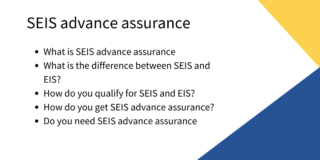Raising money for startups and SMEs in the UK
If you’re looking to raise money for your startup from outside investors in the UK, they may qualify for substantial tax reliefs on their investment through either the Seed Enterprise Investment Scheme (SEIS) or the Enterprise Investment Scheme (EIS), both of which are HMRC tax reliefs designed to encourage venture investment in earlier stage UK companies.
What are the SEIS and EIS schemes?
Both schemes are government-backed venture capital schemes designed to help small or medium-sized companies and social enterprises grow by attracting investment. The schemes offer various tax efficient benefits to investors in return for investment in startups and SMEs in the UK. Thus, bolstering economic growth in the UK by promoting new enterprise and entrepreneurship.
SEIS
The SEIS is designed for very early stage startups looking for seed investment. With a maximum cap of £150,000, this is really designed for “friends and family” rounds. The requirements are set out below.
EIS
The EIS is the choice for larger investments, and bigger companies – operating for up to 7 years and raising up to £12m.
(If your company is classed as ‘knowledge intensive’, which means it is heavily involved in [expensive] research and development work, you may qualify for longer time limits (up to 10 years) and be able to raise more money under this scheme (up to £20m).
What kinds of investment can you offer?
The investment class is restricted to ordinary share investments only. You will need to be able to demonstrate that the investment carries a risk that the investor will lose capital and that you’re not giving any priority to these investors over other shareholders.
That means you won’t be able to offer your SEIS or EIS investors convertible notes, loan notes, or preference shares, but it doesn’t stop you from offering these to overseas investors in your round, or to investors that elect not to use the tax reliefs (because they have already made use of them for example). The investment limits only apply to investments made by investors who are claiming a tax relief. The company benefits because investors will be more likely to invest and will take tax benefits into account when planning their potential gains.
Criteria for your startup to qualify for SEIS or EIS
Before you can offer investors a term sheet that is SEIS or EIS-ready, you’ll need to check that your company qualifies for one or both of the schemes. Qualification is based around how early-stage you are and how much you’ve already raised. The table below summarises the position under both schemes.
| SEIS | EIS |
| Maximum raise of £150,000. | Maximum raise of £5m in any tax year. A lifetime amount of £12m (or £20m for ‘knowledge intensive’ companies). |
| You must spend the money on a ‘qualifying trade’ (see below). | |
| Trading for less than 2 years. | Trading for less than 7 years, (or 10 years for ‘knowledge intensive’ companies). |
| Less than 25 employees. | Less than 250 employees (or 500 for ‘knowledge intensive’ companies). |
| Gross assets up to £200,000. | Gross assets up to £15m. |
| Your company must be ‘permanently established‘ in the UK, (see below). | |
What does the maximum raise include?
The maximum limits above are for any fundraising your company does under an EIS/SEIS scheme, under a venture capital trust (often known as a VCT), or under another state aid scheme. Fundraising you do under the SEIS for example, will count towards your limit under the EIS [and vice versa]. The limits do not include fundraising you do from other sources.
What is a ‘qualifying trade’?
All trades qualify for SEIS/EIS, unless they consist wholly, or substantially of ‘excluded activities’. The list below are ‘excluded activities’. If your company is making more than 20% of its revenue from any of these, it’s probable you will not be able to qualify for the reliefs.
- Land or property development
- Banking and financial services
- Benefiting from someone else’s trade marks
- Legal or accountancy services.
- Farming, agriculture and forestry
- Shipbuilding
- Coal and steel and other non-renewables.
- Hotels and nursing homes
What does it mean to be ‘permanently established’ in the UK?
The rules around ‘permanent establishment’ can be a bit tricky. The table below is intended to give you a good starting point. You will of course need to check with HMRC if your company setup is unusual.
| Company setup | Permanently established in the UK? |
| Private limited company operating in the UK. | Yes, if you can show a place of management, a branch, a workshop, or some other project area. |
| UK holding company | If you’re a holding company, the business of your trading subsidiaries doesn’t have to be carried on from your premises. The administrative and management functions of your company will likely be enough to count for the permanent establishment condition. |
| Overseas holding company | If you’re an overseas-registered parent company, you must have a permanent establishment in the UK yourself in order to qualify. You won’t be treated as having this merely by having a subsidiary which: is resident in the UK; andcarries on its business there. |
| UK agent | Your company will have a permanent establishment in the UK if it has an agent: based in the UK; andwho has the authority to enter into contracts on behalf of your company; andwho frequently uses this authority to enter your company into binding agreements. |
Can you check in advance with HMRC to be sure you are SEIS/EIS compliant?
HMRC runs an advance clearance process called `HMRC Advance Assurance`. You can take advantage of this to get a provisional indication from HMRC that your business is eligible to apply for tax relief for your investors.
Full eligibility will only be granted by HMRC (which of course introduces the risk to your investor that they may not qualify and they will not get their relief). It’s essential that you avoid this chicken and egg by getting the HMRC Advance Assurance before your round.
You can do this yourself, using the application form here or more simply and quickly, the Zegal expert team can do this for you. We have significant experience in dealing with HMRC and while it generally takes HMRC 6-8 weeks to process Advance Assurance applications, we find that we can usually do this more quickly and certainly more painlessly.
If you are planning to handle the application for Advance Assurance yourselves; you will need to provide:
- Details of the fundraise and the latest draft of any documents you use to explain your proposal to potential investors;
- The name and address of any prospective investors (the single most important step);
- Your business plan and financials;
- If you are a group, which companies in the group will use the investment;
- Details of all trading and activities to be carried out, and how much you expect to spend on each activity;
- A list of the amounts, dates and venture capital schemes under which you’ve previously received an investment;
- An up to date copy of the memorandum and articles of association and details of any changes you expect to make;
- A copy of the register of members from the date you apply for advance assurance;
- Details of any other agreements between the company and the shareholders;
What else do your investors need to know?
In addition to your company hitting the qualification criteria, there are also limits on how much a UK taxpayer can invest each year to get their maximum relief. The table below summarises the position for investors looking to invest in your company. These limits are the total limits so if they have already invested in another startup during this tax year, they will have correspondingly less headroom to play with.
| SEIS | EIS |
| Investors can invest a maximum of £100,000 in a single tax year, which can be spread over a number of companies. | Investors can invest no more than £1 million in a single tax year, which can be spread over a number of companies. |
Please note that investors who are not UK taxpayers are unable to take advantage of these schemes
What tax benefits will investors get from SEIS/EIS?
As the SEIS is designed to encourage investment in qualifying new seed-stage companies and the EIS is catered towards slightly later-stage qualifying companies, their respective tax benefits differ. The tax reliefs range from automatic reductions to loss relief and capital gains avoidance. See below for the key differences in relief offered by both schemes:
| SEIS | EIS |
| 50% initial income tax relief (ITR) on the total amount invested. | 30% ITR on the total amount invested. |
| 100% relief on Capital Gains Tax (CGT) after 3 years. | 100% CGT relief after 3 years, and deferral relief (if CGT gains are above annual exemption) |
| Loss relief if the company fails (even if this is within the three-year hold period) | |
| 100% relief from inheritance tax, provided the investment is held for two years. | |
What post-round paperwork do you need to complete?
After your funding round is closed and share certificates have been issued to investors, a compliance statement called the SEIS1 or EIS1 form must be sent to HMRC before your investors can be granted their tax relief.
If successful, HMRC will provide your investors with a unique investment reference number, which now allows you to issue the corresponding SEIS3 or EIS3 certificates to your investors, enabling them to claim the tax reliefs.
Read more about fundraising for your startup here:
Please note that this article does not constitute tax advice. The schemes are subject to change and if you are in any doubt about your position you should seek independent tax advice and/or talk to HMRC.





